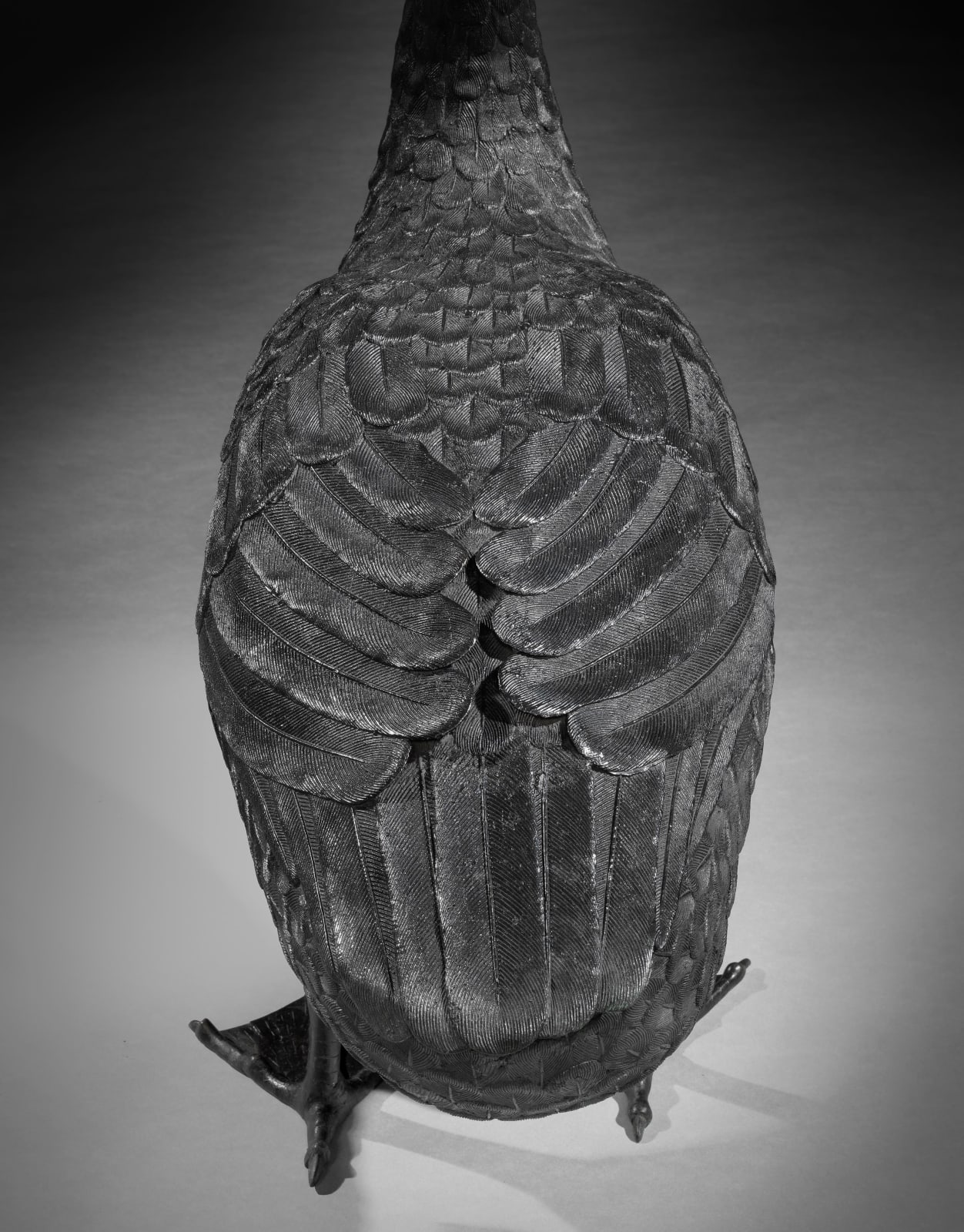A PAIR OF JAPANESE BRONZE FIGURES OF GEESE
Further images
Provenance
Charlie Chaplin, Corsier-sur-Vevey, Lake Geneva, Switzerland
Distinguished Private Collection: London, UK
Literature
Joe Earle, Splendors of Meiji: Treasures of Imperial Japan from the Khalili Collection, The Khalili Family Trust, 1999.
Oliver Impey and Malcolm Fairley, Meiji no Takara: Treasures of Imperial Japan – Metalwork, 2 vols., The Nasser D. Khalili Collection of Japanese Art, 1995.
Suzuki, Daisetz T., Zen and Japanese Culture, Princeton University Press, 1959.
Christine Guth, Art, Tea and Industry: Masuda Takashi and the Mitsui Circle, Princeton University Press, 1993
A Rare and Striking Pair of Life-Size Japanese Bronze Geese
Japan, Late Edo to Meiji period, mid-19th century
This exceptional pair of life-size bronze geese captures the naturalistic vitality and technical brilliance for which Japanese bronze sculpture is renowned. Each bird is rendered with its head raised and beak agape in mid-cry, conveying a vivid sense of animation and alertness. The finely articulated plumage—meticulously chased and textured across the surface—lends a striking sense of realism, while the careful modelling of the webbed feet and subtle posture variations demonstrate the sculptor’s acute observation of nature.
Although these geese reflect the flourishing bronze artistry of the Meiji period (1868–1912)—when Japanese metalwork reached new technical heights in response to international demand—they could equally date from the late Edo period (1603–1868). The restraint and elegance of form, and the absence of overt gilding or polychrome decoration, suggest an affinity with earlier Edo-period aesthetics, when bronze was more often used for temple, garden, or scholarly contexts rather than export.
Symbolism and Cultural Significance in Japanese Art
In Japanese artistic tradition, animals carry profound symbolic meanings, and the goose (or kari, 雁) is especially significant. Known for its lifelong pair bonds and seasonal migrations, the goose has long been associated with marital harmony, fidelity, and spiritual constancy. Depicted in pairs, as here, they evoke ideals of unity and enduring companionship—key tenets of both Confucian social order and Buddhist spiritual philosophy.
Geese also figure prominently in classical Japanese literature and poetry, such as the Manyōshū and Kokinshū, where their solitary calls often express the melancholy beauty of autumn and the impermanence of worldly life—an emotional response known as mono no aware (物の哀れ). In both painting and sculpture, the inclusion of geese reflects a reverence for nature and the passing of time, reinforcing their status as poetic and philosophical symbols in Japanese visual culture.
Comparative Examples: Edo and Meiji Periods
Bronze animal sculptures of this scale and refinement are rare and were executed by highly skilled workshops across both the Edo and Meiji periods.
From the late Edo period, comparable works include:
• A life-size bronze goose with similarly realistic modelling formerly in the Hosomi Museum, Kyoto, attributed to an anonymous 19th-century Kyoto school metalworker.
• A standing bronze crane of Edo period origin in the Tokyo National Museum, notable for its comparable chiselled plumage and poised, naturalistic stance.
• A pair of temple garden cranes from the Edo period (mid-19th century) in the Nezu Museum, which share stylistic restraint and reverence for anatomical accuracy.
From the Meiji period, comparable examples include:
• A life-size bronze goose attributed to the Miyao Company, held by the Los Angeles County Museum of Art (LACMA), with a similar upward gaze and detailed featherwork.
• Another goose, slightly smaller in scale but similarly animated, in the Museum of Fine Arts, Boston, part of their distinguished collection of Meiji decorative arts.
• A closely related pair of bronze geese from the Richard R. Silverman Collection, exhibited in Meiji: Japanese Art from the Imperial Period, which also display vivid featherwork and expressive open-beaked gestures.
While the most prominent Meiji bronzes were often destined for export, earlier Edo-period examples were more frequently created for Japanese patrons—temples, literati, and noble households—offering a quieter, more introspective elegance, as seen in the present pair.
Artistic and Collecting Importance
These geese are not merely decorative bronzes but sculptures imbued with symbolic, emotional, and philosophical depth. Whether cast during the final decades of the Edo period or the early years of Meiji, they reflect Japan’s enduring reverence for nature, executed through masterful technique and refined aesthetic sensitivity.
Their life-size scale, lifelike presence, and finely judged animation lend them a sculptural gravitas rare in either period. As a complete pair—still united—they are a rare survival of Japanese bronze artistry at its finest: a marriage of poetic symbolism and technical perfection that transcends time and continues to resonate with collectors and scholars alike.





